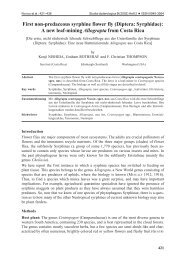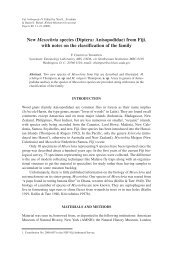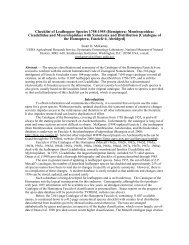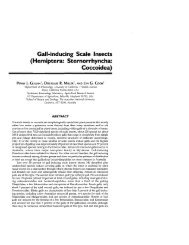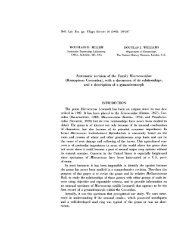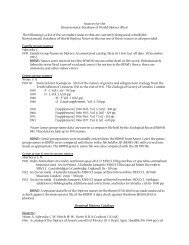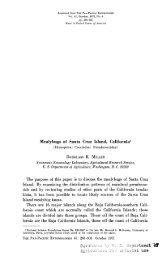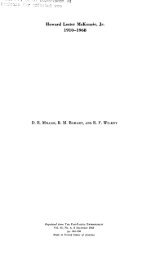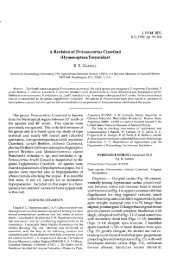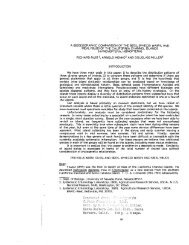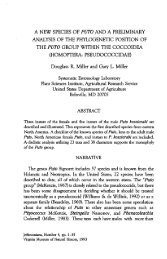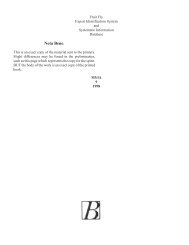SYSTEMATICS SOLVES PROBLEMS IN AGRICULTURE AND ...
SYSTEMATICS SOLVES PROBLEMS IN AGRICULTURE AND ...
SYSTEMATICS SOLVES PROBLEMS IN AGRICULTURE AND ...
Create successful ePaper yourself
Turn your PDF publications into a flip-book with our unique Google optimized e-Paper software.
<strong>SYSTEMATICS</strong> <strong>SOLVES</strong><br />
<strong>PROBLEMS</strong> <strong>IN</strong> <strong>AGRICULTURE</strong><br />
<strong>AND</strong> FORESTRYl<br />
Amy y. Rossman 2 and<br />
Douglass R. Miller 2<br />
ABSTRACT<br />
In forest and agricultural ecosystems the conspicuous elements, namely the trees, crop plants, and farm animals,<br />
form complex interactions with many less conspicuous organisms. These less conspicuous but specious organisms such<br />
as insects, fungi, nematodes, and bacteria can be beneficial, even essential, or they can be utterly devastating causing<br />
billions of dollars damage. Our present knowledge of the systematics of these less conspicuous organisms is limited.<br />
For some groups even the most elemental systematic understanding-an inventory, a checklist, a means of identification-is<br />
lacking. This paper presents examples in which systematics has contributed to solving a problem in agriculture<br />
and forestry. Our current agricultural practices reflect the systematic understanding of pest organisms that influence<br />
crop productivity. The success of efforts to discover and develop biological agents that control agricultural pests and<br />
pathogens depends on systematics. International exchange of agricultural commmodities can be enhanced or hindered<br />
by accurate or inaccurate systematic knowledge as exemplified by the recently opened market for California wheat to<br />
the People's Republic of China. Systematics is essential in directing the collection, organization, and use of vascular<br />
plant germplasm as for breeding improved crops. Forests in eastern North America have been devastated by the<br />
introduction of exotic pests and pathogens. Systematic knowledge helps to prevent such introductions. In Australia<br />
native forests threatened with extinction from an introduced weed were saved by the biological control of that weed<br />
using a fungus. Detailed systematic knowledge of both the host and pathogen allowed the safe and effective introduction<br />
of this biocontrol agent. In all the examples detailed in this paper, basic systematic knowledge was essential to solving<br />
important problems in agriculture and forestry.<br />
Trees, crop plants, and farm animals are the most<br />
conspicuous elements in forest and agricultural<br />
ecosystems, yet these organisms have complex interactions<br />
with many less conspicuous organisms.<br />
The myriad of insects, fungi, nematodes, and bacteria<br />
that are part of these ecosystems can be beneficial,<br />
even essential, to the development of the<br />
crop, or can be utterly devastating causing billions<br />
of dollars damage. At present our knowledge of the<br />
systematics of these less conspicuous organisms is<br />
grossly limited-so limited that we often do not<br />
have even an elemental systematic understanding<br />
of their existence-an inventory, a checklist, a<br />
means of identification. These are the ecosystems<br />
upon which humanity depends for survival.<br />
Within forestry and agriculture there is an increased<br />
interest in holistic approaches to managing<br />
the biological resources on which these industries<br />
depend. Such management strategies must allow<br />
the exploitation of biological resources to provide<br />
the immediate needs of food and fiber, but also<br />
" must accommodate management approaches that<br />
minimize the impact on the environment and ensure<br />
long-term use of these resources. Such strategies<br />
include sustainable agriculture, the biological<br />
control of pest organisms, integrated pest management,<br />
and the management of forests for products<br />
other than lumber. Systematic information is the<br />
key ingredient in developing these strategies; with<br />
adequate systematic knowledge these initiatives<br />
can be successful.<br />
This paper presents examples of problems in agriculture<br />
and forestry that have been solved by applying<br />
a systematic understanding of the organisms<br />
involved. In some cases the result was to solve<br />
short-term problems with short-term economic gain,<br />
for example, in increased international trade, while<br />
in other cases the result has been incalculable,<br />
long-term benefit, such as in the biological control<br />
of an exotic weed that was threatening to destroy<br />
an entire ecosystem. In all cases basic systematic<br />
knowledge was essential to solving the problem.<br />
<strong>AGRICULTURE</strong><br />
AGRICULTURAL PRACTICES REFLECT THE SYSTEMATIC<br />
UNDERST<strong>AND</strong><strong>IN</strong>G OF PEST ORGANISMS<br />
Agricultural practices of previous centuries included<br />
empirically integrated management of crop<br />
I We thank the following systematists who contributed ideas and information to this paper: Marc Cubeta, North<br />
Carolina State University, Plymouth, North Carolina; Harry Evans, International Institute of Biocontrol, Silwood, England;<br />
and David Spooner, USDA-Agricultural Research Service, Vegetable Crops Research Unit, Madison, Wisconsin.<br />
2 USDA-Agricultural Research Service, Systematic Botany and Mycology Laboratory, Systematic Entomology Laboratory,<br />
Beltsville, Maryland 20705, U.S.A.<br />
ANN. MISSOURI BOT. CARD. 83: 17-28. 1996.
18 Annals of the<br />
Missouri Botanical Garden<br />
I.,'<br />
t~ ~<br />
~ ~~~.~~\~)'. 4/·<br />
differences were noticed in the rarely formed sexual<br />
state, and relatedness was defined on the ability of<br />
strains to undergo anastomoses or hyphal fusion.<br />
Now the R. solani complex is separated into anastomosis<br />
groups, or AGs, based on this ability. Recent<br />
molecular analyses of the anastomosis groups<br />
and increased knowledge of sexual states has allowed<br />
systematists to characterize biologically<br />
meaningful species that conelate with such important<br />
parameters as host susceptibility (Ogoshi,<br />
1987; Sneh et aI., 1991). Within the entity previously<br />
referred to as R. solani, a number of species<br />
are now recognized, some of which are pathogens<br />
specific to particular crop plants, others are myconhizal<br />
with orchids, while still others can be<br />
used as biological control agents of plant pathogenic<br />
fungi (Vilgalys & Cubeta, 1994). This crucial<br />
systematic information allows plant pathologists to<br />
recognize and seek out control strategies for the<br />
species that are pathogenic on specific crops, allows<br />
orchid growers to understand the positive aspects<br />
of the presence of these fungal species, and<br />
allows biological control specialists to use these<br />
fungi in their arsenal of control agents. The systematist<br />
has made order out of chaos.<br />
Figure 1. Binucleate hyphae of Rhizoctonia solani<br />
AG-4 under fluorescence (left) and dark-field microscopy<br />
(right). Photo by Marc Cubeta.<br />
pests, often with limited success. During the last<br />
100 years, however, these limitations on agricultural<br />
productivity have been lowered, resulting in<br />
an increased human population and demand for<br />
food. Despite spectacular success, 10-20% of all<br />
agricultural crops are still lost to pests and pathogens<br />
(Anonymous, 1993). As the need to produce<br />
more agricultural commodities increases, expectations<br />
have also increased for lower chemical input<br />
to agricultural systems and products. Knowledge of<br />
the systematics of the insects, fungi, nematodes,<br />
and microorganisms that consume a significant portion<br />
of the agricultural products provides the key<br />
to solving this dilemma.<br />
For example, until recently the fungus commonly<br />
identified as Rhizoctonia solani Kuhn. was believed<br />
to be a single, widespread species that occurred on<br />
almost every vascular plant and caused root rots,<br />
barepatch, wilts, diebacks, blights, and blotches<br />
(Fan et aI., 1989; Parmeter, 1970). This fungal species<br />
produces almost exclusively vegetative hyphae<br />
(Fig. 1), albeit vegetative hyphae with distinctive<br />
morphology (Parmeter, 1970). In the past 20 years<br />
<strong>SYSTEMATICS</strong> PROVIDES THE MEANS FOR DISCOVER<strong>IN</strong>G<br />
<strong>AND</strong> DEVELOP<strong>IN</strong>G BIOLOGICAL AGENTS TO CONTROL<br />
AGRICULTURAL PESTS <strong>AND</strong> PATHOGENS<br />
Damage to agricultural crops due to fungi, both<br />
in the field and during harvest and storage, is estimated<br />
at more than $3.5 billion in the United<br />
States (Kendrick, 1992), while the dollar value from<br />
insect damage is equal or greater. Insects, nematodes,<br />
fungi, and microorganisms constantly compete<br />
with humans for these commodities. An increasingly<br />
attractive altemative to chemical control<br />
of agricultural pest organisms is through biological<br />
control or the manipulation of a biological antagonist,<br />
often a natural enemy. One suspects that considerable<br />
biological control exists in natural systems<br />
and that the interaction and balance between<br />
organisms is extremely complex.<br />
Fungi are being explored as biological control<br />
agents of insects, nematodes, plant pathogenic fungi,<br />
and noxious weeds. The fungi involved are not<br />
the macrofungi with which most people are familiar,<br />
that is, mushrooms, polypores, or lichens. Rather,<br />
the fungi having the greatest impact in agriculture<br />
and forestry are microscopic in size, often fastgrowing,<br />
and producing many tiny reproductive<br />
structures. As a group of organisms they are vastly<br />
understudied, to the extent that at least 50% of the<br />
new species with biocontrol potential have yet to
Volume 83, Number 1 Rossman & Miller 19<br />
1996 Systematics and Agriculture and Forestry<br />
be discovered and described. Fundamental systematic<br />
information, such as species descriptions and<br />
understanding of relationships with known species,<br />
is needed.<br />
One example in which systematic knowledge has<br />
contributed to the development of effective biological<br />
control concerns fungi used to control soilborne<br />
fungal diseases in temperate agricultural systems.<br />
Like many Ascomycetes, these fungi are most commonly<br />
encountered as asexually reproducing strains<br />
for which a sexual state mayor may not be known.<br />
One of the most commonly used biocontrol strains<br />
was initially identified as Gliocladium virens Giddens,<br />
Foster & A. A. Foster. Although described in<br />
Gliocladium, this biocontrol fungus is morphologically<br />
and biologically unlike the type and other<br />
species in this genus. Using both morphological<br />
and molecular approaches, two systematists have<br />
shown that Gliocladium virens actually belongs in<br />
the relatively unstudied genus Trichoderma (Fig. 2)<br />
(Rehner & Samuels, 1994; Samuels & Rehner,<br />
1993). Based on that conclusion, one would predict<br />
the related sexual state of this fungus would be an<br />
ascomycete in the genus Hypocrea (Fig. 3). Thus,<br />
strains of the closest sexually reproducing relative,<br />
H. gelatinosa (Tode) Fr., were tested for the production<br />
of the fungal metabolite gliotoxin. Gliotoxin<br />
is con-elated with potential for biological control of<br />
fungal pathogens. Strains derived from the closely<br />
related sexual state produced as much gliotoxin as<br />
the biocontrol fungus. In addition, some of these<br />
newly discovered biocontrol strains produced their<br />
sexual states in culture, allowing conventional genetic<br />
manipulation. Thus, increased knowledge of<br />
the systematics of the Trichoderma complex led to<br />
the prediction and discovery of more effective<br />
strains of biological control fungi.<br />
Unlike the above example, agricultural problems<br />
are often solved using the bmshfire approach of<br />
reacting when an emergency arises, undertaking a<br />
nan-ow research program on the pest causing the<br />
problem, possibly finding a solution, and going on<br />
to the next agricultural bmshfire. Because comprehensive<br />
systematic knowledge is not generated in<br />
solving an immediate problem, the short-term solution<br />
does not add significantly to the development<br />
of a predictive classification system. In fact, in<br />
many situations systematic analysis of a single species,<br />
removed from the context of phylogeny and<br />
biogeography, and not carefully integrated into a<br />
classification system, detracts rather than adds useful<br />
information. An example of a circumstance<br />
where comprehensive research followed a brushfire<br />
solution involved a pest in Africa. An unknown<br />
mealybug attacked cassava in West Africa (Fig. 4)<br />
and cost farmers £1.4 billion each year (Anonymous,<br />
1986). A systematist described the species<br />
(Phenacoccus manihoti) as new and, based on the<br />
systematic relationship of this species with others,<br />
suggested that natural enemy exploration be undertaken<br />
in Central and South America (Matile<br />
Fen-ero, 1977). Additional specimens of a mealybug<br />
en-oneously identified as P. manihoti were<br />
discovered in northern South America, and several<br />
of its parasites were imported to Mrica. Unfortunately,<br />
none of the biological control agents were<br />
effective, and a mealybug systematist was asked to<br />
study the South American material. The systematist<br />
determined that the mealybug from northern South<br />
America actually was a second species different<br />
from P. manihoti described from Africa (Cox & Williams,<br />
1981). Eventually true P. manihoti was located<br />
further south in South America, and effective<br />
parasites were discovered and successfully introduced<br />
into West Africa (Hen-en & Neuenschwander,<br />
1991). After this brushfire was put out, the<br />
International Fund for Agricultural Development<br />
offered financial support for a study on the mealybugs<br />
of South America. A book has recently been<br />
published (Williams & Grana de Willink, 1992)<br />
that serves as a first step toward understanding the<br />
diverse mealybug fauna of the area and prepares<br />
the world for the emergence of the next devastating<br />
mealybug pest.<br />
<strong>IN</strong>TERNATIONAL EXCHANGE OF AGRICULTURAL<br />
COMMODITIES DEPENDS ON ACCURATE SYSTEMATIC<br />
<strong>IN</strong>FORMATION<br />
International exchange of agricultural commodities<br />
in the United States was valued at $24 billion<br />
for imports and $42 billion for exports in 1992,<br />
accounting for a significant portion of total domestic<br />
expOits (Anonymous, 1993). Regulations governing<br />
the international exchange of agricultural and forest<br />
commodities are directed at the containment of economically<br />
damaging organisms. Thus, such exchange<br />
requires the accurate and rapid identification<br />
of both domestic and exotic pests and<br />
pathogens. Systematists provide the expertise and<br />
tools on which these identifications are made, allowing<br />
the existence of this multibillion dollar industry.<br />
The smut fungi, Ustilaginales, cause severe diseases<br />
of important grain crops (Fig. 5). Although<br />
relatively well surveyed and described, these obligate<br />
parasites are generally considered to be host<br />
specific and are identified primarily based on teliospore<br />
characteristics. Their identification is difficult<br />
and requires taxonomic expertise, particularly
20 Annals of the<br />
Missouri Botanical Garden<br />
Figure 2. SEM of Trichoderma virens, a fungus with potential for the biological control of plant pathogenic fungi.<br />
Photo by James Plaskowitz.<br />
wheal (Triticum aestivum L.) imported into Canada<br />
from the United States was determined to be con<br />
taminated with Tilletia indica. Plant quarantine of<br />
ficials in both the U.S. and Canada became quite<br />
excited, and a ban on the import of wheat from the<br />
U.S. to Canada was suggested. A systematist who<br />
if the host is unknown or misidentified. Tilletia indica<br />
(Mitra) Mundkur, kamal bunt of wheat, is a<br />
smut fungus that occurs in limited regions of the<br />
world (Green, 1984; Smith et a!', 1992; Waller &<br />
Mordue, 1983). Extreme vigilance is required to<br />
prevent the spread of this pathogen. Recently,
Volume 83, Number 1 Rossman & Miller 21<br />
1996 Systematics and Agriculture and Forestry<br />
~<br />
Figure 3. Asci with 16 partspores of Hypocrea gelatinosa,<br />
the sexual state of Trichoderma virens.<br />
was asked to study the material correctly identified<br />
the smut as Tilletia barclayana (Bre£.) Sacco & Syd.<br />
This smut fungus occurs on rice and apparently<br />
contaminated the wheat when it was stored in a<br />
warehouse that had previously contained rice. This<br />
identification was eventually confirmed with isozyme<br />
analysis, and a potentially costly international<br />
incident was averted (Mary Palm, pers. comm.,<br />
1993).<br />
Systematic knowledge of another smut fungus on<br />
wheat and the clarification of the circumstances under<br />
which it was collected have allowed the sale of<br />
wheat from California to the People's Republic of<br />
China. Export of wheat from the Pacific Northwest<br />
of the United States to the People's Republic of<br />
China has been curtailed since 1972 because of<br />
the presence of Tilletia controversa Kiihn., dwarf<br />
bunt, a fungus not known to occur in China. A<br />
second bunt disease of wheat, common bunt or<br />
rough-spored bunt, is caused by T. tritici (Bjerk.)<br />
Wolff and occurs throughout the world wherever<br />
wheat is grown (Anonymous, 1990; Mordue & Waller,<br />
1981). Differentiating teliospores of T. tritici<br />
from T. controversa is difficult to impossible be<br />
Figure 4. Cassava trees in West Africa. The tree on<br />
the right attacked by the mealybug Phenacoccus manihoti<br />
has not produced large, edible tubers, while the one on<br />
the left is free of mealybug attack and shows normal tuber<br />
production.<br />
cause of their morphological similarity. Thus, it is<br />
important to know if dwarf bunt is present, absent,<br />
or has ever occurred in specific regions in the U.S.<br />
from which wheat might be shipped to the People's<br />
Republic of China. The wheat-growing regions of<br />
California are free of dwarf bunt except for one report<br />
of T. controversa (Duran & Fischer, 1956). This<br />
report curtailed the export of wheat from California<br />
to China. The report of dwarf bunt in California was<br />
based on a specimen collected [on June 30, 1917<br />
in Jacksonville, "California"] by a U.S. Department<br />
of Agriculture plant pathologist, H. B. Humphrey.<br />
The specimen was deposited in the U.S. National<br />
Fungus Collections and was available for study. Despite<br />
intense efforts using morphological, biochemical,<br />
and molecular means, it was not possible to<br />
identify this specimen as either T. tritici or T. controversa.<br />
Since identification was not possible, a<br />
new strategy was devised that again depended on<br />
systematic facilities. All specimen label data associated<br />
with the specimens at the U.S. National<br />
Fungus Collections had previously been entered
22 Annals of the<br />
Missouri Botanical Garden<br />
As a consequence, the People's Republic of China<br />
has lifted the quarantine on the import of wheat<br />
from California. According to the California Wheat<br />
Commission (B. Fernandez, pel's. comm.), a first<br />
shipment of California wheat to the People's Republic<br />
of China left Stockton on April 1, 1995. This<br />
first shipment of 30,000 tons is worth about $4.7<br />
million. Solving this systematic problem has<br />
opened a multimillion dollar market.<br />
<strong>SYSTEMATICS</strong> DIRECTS THE COLLECTION, ORGANIZATION,<br />
<strong>AND</strong> USE OF VASCULAR PLANT GERMPLASM<br />
Figure 5. Corn smut fungus, Ustilago maydis, infecting<br />
kernels of field corn in Maryland.<br />
into a computerized database. Using this systematic<br />
infonnation resource, it was possible to determine<br />
the approximate route of Humphrey on his 1917<br />
trip (fable 1). Although this database was never<br />
intended for tracking a scientific expedition, it provided<br />
the information necessary to prove that the<br />
dwarf bunt specimen was collected in Jacksonville,<br />
Oregon, not in California. This fact was confinned<br />
by the itinerary and telegrams of H. B. Humphrey<br />
for this trip deposited and maintained at the U.S.<br />
National Archives. Using these sources of information<br />
it was proven that this dwarf bunt specimen<br />
was not collected in California (Rossman, 1994).<br />
Humankind has always assumed that the genetic<br />
resources required to support agriculture would<br />
continue to exist in nature forever. As an indication<br />
of the importance of genetic resource preservation,<br />
Congress has recently mandated that the United<br />
States Department of Agriculture formulate a program<br />
to develop, store, and access genetic resources<br />
for all kinds of living organisms (National<br />
Research Council, 1991). The report on specifically<br />
how this could be done and how much it would<br />
cost has been presented to them. This program includes<br />
not only vascular plants and animals of obvious<br />
importance to agriculture but also fungi, insects,<br />
nematodes, and microorganisms. Congress<br />
recognizes the essential role that biological diversity<br />
plays in human existence. The problem is how<br />
to obtain, organize, preserve, and utilize the genetic<br />
resources needed to insure that future agricultural<br />
needs will be met. The critical basis for developing<br />
and utilizing genetic resources is systematic knowledge<br />
(Shands & Kirkbride, 1989).<br />
For vascular plant germplasm in the United<br />
States, a large system of repositories exists. The<br />
U.S. National Plant Germplasm System contains 5<br />
10% of the 250,000 vascular plant species in existence<br />
(National Research Council, 1993). Information<br />
on the over 400,000 accessions is based on<br />
the systematics of the organisms using the Germplasm<br />
Resources Information Network. Entry to accession<br />
information is through the scientific name<br />
of the species, and all communications depend on<br />
Table 1. Route taken by H. B. Humphrey in 1917 as determined by collection data on specimens deposited in the<br />
U.S. National Fungus Collections.<br />
Specimens collected by H. B. Humphrey in 1917 deposited in the U.S. National Fungus Collections<br />
• June 24 1917 Campbell, Santa Clare County, California<br />
• June 30 1917 Medford, Oregon<br />
• June 30 1917 Jacksonville, California (actually Oregon)<br />
• July 4 1917 Pullman, Washington<br />
• July 9 1917 51. Paul, Minnesota
Volume 83, Number 1 Rossman & Miller 23<br />
1996 Systematics and Agriculture and Forestry<br />
\<br />
\<br />
Figure 6. John Wiersema, nomenclaturalist, reviewing scientific names of vascular plants in the Germplasm Resources<br />
Information Network.<br />
accurate nomenclature as determined by a systematist<br />
specializing in the classification of cultivated<br />
plants (Fig. 6). The systematist provides information<br />
on the relatedness and therefore the usefulness<br />
of the germplasm to its potential crop.<br />
Repositories of vascular plant germplasm set<br />
their priorities for collecting and utilizing germplasm<br />
based on systematic knowledge of crop<br />
plants and their immediate relatives. For example,<br />
the numerous wild relatives of the cultivated potato<br />
provide the genetic basis for disease resistance that<br />
is present in today's crop. Cultivated potato is consumed<br />
worldwide and represents the fourth most<br />
important food resource (Hawkes, 1990). In the native<br />
habitat of wild potatoes ranging from the southwestern<br />
United States to south-central Chile, these<br />
relatives are often obscure weeds and are not used<br />
locally as food; indeed, some are mildly poisonous.<br />
David Spooner's research on wild potatoes (Solanum<br />
sect. Petota) illustrates the value of systematics<br />
infOlmation to plant breeding. Spooner's research<br />
has two components--collecting for more<br />
complete germplasm representation in genebanks<br />
and systematics research to understand the species<br />
and their relationships with Solanum sect. Petota.<br />
His program, collecting in collaboration with researchers<br />
from South America, has resulted in the<br />
acquIsition of more than 20 species-relatives of<br />
the cultivated potato-not present in the world's<br />
genebanks.<br />
The world's largest collection of potato germplasm<br />
at Sturgeon Bay, Wisconsin, holds about<br />
5000 accessions (Bamberg & Spooner, 1994) of<br />
about 170 of the 232 wild potato species recognized<br />
in the latest comprehensive taxonomic treatment of<br />
Solanum sect. Petota (Hawkes, 1990). At present,<br />
there are disagreements among taxonomists regarding<br />
the species, hypotheses of natural interspecific<br />
hybridization, and the relationships among taxa of<br />
cultivated and wild potato. The treatment previous<br />
to Hawkes (1990) recognized only 157 species, and<br />
the species boundaries and their interrelationships<br />
have yet to be reconciled (Spooner & van den Berg,<br />
1992). Thus, Spooner's ongoing research program<br />
using a variety of tools to investigate the identity<br />
and relationships among these species is crucial for<br />
the enhancement of commercial potato products<br />
(Giannattasio & Spooner, 1994a, b; Spooner et aI.,<br />
1993; Spooner & Sytsma, 1992). Because it takes<br />
8-15 years from the initiation of a breeding program<br />
to a commercial variety release, considerable<br />
time and expense can be saved by making an initial<br />
choice of breeding material based on accurate systematic<br />
knowledge.
24 Annals of the<br />
Missouri Botanical Garden<br />
FORESTRY<br />
Forest land in the United States occupies 737<br />
million acres, yielding products valued at about $1<br />
billion in 1992 (Anonymous, 1993). Other forest<br />
commodities and non-commodity uses such as recreation<br />
and watershed resources have an even<br />
greater value. Changes in the public's perception<br />
of the value of forest lands have led to a major shift<br />
in their management. This new management philosophy<br />
has resulted in older tree stands and in<br />
greater value of non-timber species. Long-term forest<br />
system management has a different set of problems<br />
than those associated with traditional forest<br />
management. While most forest managers measure<br />
physical and chemical aspects of their forest as well<br />
as monitor changes in the macrofauna and flora,<br />
they generally are unable to measure the biological<br />
diversity of the total forest biota. Knowledge of the<br />
systematics of non-timber components of forest ecosystems<br />
is essential to their sustainable maintenance.<br />
SYSTEMATIC KNOWLEDGE HELPS PREVENT THE<br />
<strong>IN</strong>TRODUCTION OF EXOTIC PESTS <strong>AND</strong> PATHOGENS THAT<br />
DESTROY FORESTS<br />
A major force in the destruction of forests, aside<br />
from harvesting of trees, has been damage inflicted<br />
by introduced forest pests and pathogens. The economic<br />
loss to timber revenues is estimated at $2<br />
billion annually (Campbell & Schlarbaum, 1994),<br />
with a much greater loss in recreational value. The<br />
infamous American chestnut blight introduced on<br />
Asian chestnut nursery stock in 1904 has altered<br />
the landscape of the eastern deciduous forest forever<br />
(Anagnostakis, 1987). Yet nursery stock and<br />
unrefined logs are imported into the United States<br />
without thorough knowledge and understanding of<br />
the organisms associated with them (Campbell &<br />
Schlarbaum, 1994; Redlin, 1991). The fungus<br />
causing dogwood anthracnose, Discula destructiva<br />
Redlin (Fig. 7), was described only recently (Redlin,<br />
1991) but its origin is still unknown because<br />
of inadequate baseline data on the fungi in the<br />
United States and the rest of the world. Its simultaneous<br />
appearance on both coasts of North America<br />
suggests that it was introduced on nursery stock<br />
(Campbell & Schlarbaum, 1994). Increased systematic<br />
knowledge of the inconspicuous organisms<br />
that occupy forests worldwide is needed to prevent<br />
additional destructive introductions.<br />
Systematic tools for the rapid identification of potentially<br />
harmful organisms also will avert future<br />
disasters. In 1993 a ship arrived in Wilmington,<br />
North Carolina, carrying a cargo of military goods<br />
from Germany. When the ship's holds were opened,<br />
moths were seen flying from the cargo areas. Agricultural<br />
quarantine inspectors closed the holds<br />
and set the ship back out to sea. The insects appeared<br />
to be the gypsy moth but inspectors were<br />
unsure whether they were the European gypsy<br />
moth, which is established on the East Coast from<br />
an earlier introduction, or the Asian gypsy moth,<br />
which does not occur in the U.S. and is notable for<br />
its flying females. The samples were shipped to<br />
Delaware, Ohio, where systematic specialists used<br />
molecular techniques to quickly identify the specimens<br />
as the Asian gypsy moth. The ship's cargo<br />
areas were fumigated, and a trapping program<br />
around the port was initiated to eradicate the Asian<br />
gypsy moth before it could become established.<br />
Previous development of a rapid identification<br />
method by systematists had given quarantine decision<br />
makers the tools to avert the establishment<br />
of a potentially damaging exotic pest.<br />
Decisions to allow the importation of agricultural<br />
and forestry commodities into the United States are<br />
generally based on whether a potentially damaging<br />
organism already exists in this country. Unfortunately,<br />
this assumes that these organisms are known<br />
and accurately identified in the U.S. At present<br />
only about 50% of the insects (Kosztarab & Schaefer,<br />
1990) and 2Q.-40% of the fungi in the U.S. have<br />
been described (Klassen, 1986). A database has<br />
been developed of reports of fungi on plants and<br />
plant products in the United States (Farr et al.,<br />
1989). This database is one of the primary resources<br />
on which the Animal and Plant Health Inspection<br />
Service depends when making decisions<br />
about entry of commodities into the United States.<br />
Previously this information was scattered and difficult<br />
or impossible for decision makers to obtain.<br />
Now with a single source of systematic information,<br />
more knowledgeable decisions can be made. In<br />
some cases this information has allowed the importation<br />
of plant products that previously were<br />
prohibited entry because of the lack of knowledge<br />
about the organisms in the United States.<br />
Although this database is the most comprehensive<br />
account of plant-associated fungi in the world,<br />
listing 13,000 species (Farr et aI., 1989), it is far<br />
from complete, particularly for fungi on non-crop<br />
plants. The fungi reported in the literature are usually<br />
those that are conspicuous or cause damage to<br />
plants of economic interest. We now know that<br />
there are potentially pathogenic fungi that live inside<br />
apparently healthy plant tissue (Carroll, 1988).<br />
Visual inspection of such plants does not detect<br />
these latent pathogenic fungal species. As an example<br />
of the inadequate knowledge of fungi in the
Volume 83, Number 1 Rossman & Miller 25<br />
1996 Systematics and Agriculture and Forestry<br />
Figure 7. Conidiomata and conidia of fungus causing dogwood anthracnose, Discula destrnetiva, erumpenl through<br />
leaf epidermis.<br />
U.S., we compared from various sources the fungi<br />
known to occur on one host, Chamaecyparis thyoides<br />
(L.) B.S.P., Atlantic white cedar (Table 2). Although<br />
not an inconspicuous host, this tree is not<br />
of profound economic importance. In FaIT et al.<br />
(1989) 40 species are listed on this host. In the<br />
U.S. National Fungus Collections, 50 species are<br />
represented, of which only 9 are included in FaIT
26 Annals of the<br />
Missouri Botanical Garden<br />
Table 2. Fungi reported on Chamaecyparis thyoides,<br />
Atlantic white cedar. FOPP (Farr et aI., 1989), USNFC<br />
(U.S. National Fungus Collections), Bills & Polishook<br />
(1992).<br />
Fungi known on Chamaecyparis thyoides,<br />
Atlantic White Cedar<br />
Bills &<br />
FOPP USNFC Polishook<br />
FOPP<br />
USNFC<br />
Bills & Polishook<br />
40 9<br />
41<br />
3<br />
2<br />
72<br />
40 50 77<br />
Total number of species 153<br />
et al. (1989). Based on these two resources alone,<br />
81 fungal species are known from this host. In just<br />
one study Bills & Polishook (1992) isolated 77 fungal<br />
species occurring as endophytes in living tissue<br />
of this host. Of these, only three species were listed<br />
in FaIT et al. {l989), while two species were represented<br />
in the U.S. National Fungus Collections.<br />
From these three resources 153 fungal species are<br />
known on Chamaecyparis thyoides, of which only<br />
40, or about 25%, are reported in FaIT et al. (1989).<br />
These data suggest that by simply gathering information<br />
from our systematic collections, we can enhance<br />
the knowledge base considerably. Then, in<br />
this case, by undertaking even cursory sampling<br />
activities, we can again double the number of fungal<br />
species known from that host. This fundamental<br />
knowledge of the organisms that occur in the United<br />
States is needed to make enlightened decisions<br />
about the safety of allowing entry of agricultural<br />
and other plant commodities into this country.<br />
SYSTEMATIC KNOWLEDGE OF HOST <strong>AND</strong> PATHOGEN IS<br />
NEEDED TO CONTROL EXOTIC ORGANISMS<br />
Introduced organisms that threaten forest ecosystems<br />
as well as grazing lands can be controlled<br />
using biological agents. To be successful, systematic<br />
knowledge of both the biocontrol agent and target<br />
organisms is critical. For example, in northern<br />
Queensland, Australia, a noxious weed known as<br />
rubbervine, Cryptostegia grandifiora Roxb. ex R.<br />
Br. (Asclepiadaceae: Periplocoideae), has ruined<br />
grazing lands and threatened the native forests by<br />
completely covering the trees. Exotic to Australia,<br />
where it was intentionally introduced over a century<br />
ago to cover spoils from gold mines, this perennial,<br />
woody, climbing shrub still exists in relictual but<br />
threatened populations in its native habitat of Madagascar<br />
(Evans, 1993). To solve the weed problem<br />
in Australia, the native plant populations in Madagascar<br />
were examined for both fungus and insect<br />
natural enemies. Although insects were located,<br />
none were found to be host specific and thus were<br />
not considered safe for introduction into Australia.<br />
A rust fungus (Uredinales) with biocontrol potential<br />
was collected by Harry C. Evans of the International<br />
Institute of Biological Control in 1987<br />
1988. Unfortunately, this rust was considered to belong<br />
in the genus Hemileia Berk. & Broome, in<br />
which is also placed the notorious coffee rust fungus<br />
H. vastatrix Berk. & Broome. The rust pathogen<br />
of rubbervine had been described in 1914 but literally<br />
ignored for decades because of its seeming<br />
lack of economic importance. Evans (1993) undertook<br />
a systematic study of this potential biological<br />
control agent and discovered that the nuclear condition<br />
of supposed urediniospores was that of a sexually<br />
reproducing fungus, thus what appeared to be<br />
urediniospores were actually teliospores or the sexual<br />
spores of the rust. Under conditions of low humidity,<br />
such as occur in the semiarid parts of Madagascar,<br />
these prolific urediniospore-like teliospores<br />
were produced in abundance. However, with high humidity,<br />
such as in a greenhouse in the United Kingdom<br />
or as occurs only occasionally in this region of<br />
Madagascar, true teliospores are produced that eventually<br />
germinate to form a variable number of basidiospores.<br />
This rare phenomenon reveals the evolutionary<br />
history of this fungus as well as its closer<br />
relationship with another group of rusts. This rust is<br />
now placed in Maravalia Arthur in the Chaconiaceae,<br />
Uredinales, only distantly related to Hemileia.<br />
Biological control agents must be host specific.<br />
In testing for host specificity, close relatives of<br />
Cryptostegia grandifiora in the Asclepidaceae were<br />
examined for susceptibility to the rust fungus.<br />
While the target plant proved to be highly susceptible,<br />
related species demonstrated a range of resistance<br />
that reflected the relationships among the<br />
host plants. For example, within the subfamily Periplocoideae<br />
of the Asclepiadaceae, the closest related<br />
genus, Gymnanthera R. Br., proved to be<br />
highly resistant with a response that included hyphal<br />
collapse after penetration. In another related<br />
plant species, Finlaysonia obovata Wall., the formation<br />
of sori was initiated but pustules did not<br />
mature (Evans & Fleureau, 1993). On two species<br />
in the subfamily, Gonocrypta grevei Baill. and Cryptolepis<br />
grayi P. I. Forst., fertile sori did develop in<br />
greenhouse tests. Further studies on ecotypes of G.<br />
grevei demonstrated population differences with<br />
sporulation on certain plants occurring only at saturation<br />
inoculum levels. Based on 1bese findings,<br />
two physiological races of the rust fungus were dis
Volume 83, Number 1<br />
Rossman & Miller<br />
1996 Systematics and Agriculture and Forestry<br />
27<br />
tinguished, one adapted to Cryptostegia, and the<br />
other to Gonoerypta. This was corroborated by the<br />
~<br />
field observation that rusted Cryplostegia grandiflora<br />
grew intertwined with healthy Gonocrypta grevei<br />
(Evans & Tomley, 1994). As a result of increased<br />
systematic knowledge of a rust fungus, Maravalia<br />
cryptostegia (Cummins) Ono, and of the host plant<br />
and its relatives, rubbervine in Australia is no longer<br />
devastating the forest ecosystem.<br />
This success story is the result of an extremely<br />
small piece of the entire systematics puzzle; most<br />
pieces of the puzzle remain separated. If there existed<br />
a thorough systematic understanding of a majority<br />
of the rust fungi, the potential for controlling<br />
exotic weeds such as rubbervine would be increased.<br />
In some parts of the world exotic weeds<br />
threaten the extinction of more biological diversity<br />
than the threat of habitat destruction from human<br />
activity (U.S. Congress, 1993). Lack of systematic<br />
knowledge is hindering use of biological control<br />
agents to stop the destruction of endangered native<br />
habitats due to exotic weeds. Given the ability of<br />
one rust species to control a noxious weed that<br />
threatened a native forest in Australia, imagine the<br />
untapped potential for the use of fungi as biological<br />
control agents. Systematics is the key to achieving<br />
that potential.<br />
CONCLUSION<br />
Many costly problems in agriculture and forestry<br />
could be solved with increased systematic knowledge<br />
of the inconspicuous organisms that influence<br />
forest and agricultural ecosystems. Systematics provides<br />
the means to use and benefit, rather than suffer,<br />
from their biological influence. The economic<br />
payoff from using systematic knowledge to solve<br />
problems in agriculture and forestry is far greater<br />
than the cost of funding a systematics research program.<br />
Literature Cited<br />
Anagnostakis, S. 1987. Chestnut blight: The classical<br />
problem of an introduced pathogen. Mycologia 79: 23<br />
37.<br />
Anonymous. 1986. The one billion pounds a year mealybug<br />
brings in more projects. CAB International News,<br />
October 1986: 6-7.<br />
Anonymous. 1990. Distribution maps of plant diseases.<br />
Tilletia indica. Map No. 290. 2nd ed. lnt. Myco!. Inst.,<br />
Kew, England.<br />
Anonymous. 1993. Agricultural Statistics 1993. Government<br />
Printing Office, Washington, D.C.<br />
Bamberg, J. B. & D. M. Spooner. 1994. The United States<br />
potato introduction station herbarium. Taxon 43: 489<br />
496.<br />
Bills, G. F. & J. D. Polishook. 1992. Recovery of endophytic<br />
fungi from Chamaecyparis thyoides. Sydowia 44:<br />
1-12.<br />
Campbell, F. T. & S. E. Schlarbaum. 1994. Fading Forests.<br />
North American Trees and the Threat of Exotic<br />
Pests. Natural Resources Defense Council, New York.<br />
Carroll, G. 1988. Fungal endophytes in stems and leaves:<br />
Fmm latent pathogen to mutualistic symbiont. Ecology<br />
69: 2-9.<br />
Cox, J. M. & D. J. Williams. 1981. An account of cassava<br />
mealybugs with a description of a neW species. Bul!.<br />
Entomo!' Res. 71: 247-258.<br />
Duran, R. & G. W. Fischer. 1956. The genus Tilletia.<br />
Washington State Univ. Press, Pullman, Washington.<br />
Evans, H. C. 1993. Studies on the rust, Maravalia cryptostegiae,<br />
a potential biological control agent of rubbervine<br />
weed, Cryptostegia grandiflora (Asclepiadaceae:<br />
Periplocoideae), in Australia, I: Life-cycle. Mycopathologia<br />
124: 163-174.<br />
---& L. Fleureau. 1993. Studies on the rust, Maravalia<br />
cryptostegiae, a potential biological control agent<br />
of rubber-vine weed, Cryptostegia grandiflora (Asclepiadaceae:<br />
Periplocoideae), in Australia, II: Infection.<br />
Mycopathologia 124: 17~184.<br />
---& A. J. Tomley. 1994. Studies on the rust, Maravalia<br />
cryptostegiae, a potential biological control agent<br />
of rubber-vine weed, Cryptostegia grandiflora (Asclepiadaceae:<br />
Periplocoideae), in Australia, HI: Host<br />
range. Mycopathologia 126: 93-108.<br />
Farr, D. F., G. F. Bills, G. P. Chamuris & A. Y. Rossman.<br />
1989. Fungi on Plants and Plant Products in the United<br />
States. American Phytopathology Society, St. Paul, Minnesota.<br />
Giannattasio, R. B. & D. M. Spooner. 1994a. A reexamination<br />
of species boundaries between Solanum megistacrolobum<br />
and S. toralapanum (Solanum sect. Petota,<br />
series Megistacroloba): Morphological data. Syst. Bot.<br />
19: 89-105.<br />
---& ---. 1994b. A reexamination of species<br />
boundaries between Solanum megistacrolobum and S.<br />
toralapanum (Solanum sect. Petota, series Megistacroloba):<br />
Molecular data. Syst. Bot. 19: 106-115.<br />
Green, A. 1984. Pests not known to occur in the United<br />
States or oflimited distribution: Tilletia indica. PNKTO<br />
58: 1-8.<br />
Hawkes, J. G. 1990. The Potato: Evolution, Biodiversity,<br />
and Genetic Resources. Smithsonian Institution Press,<br />
Washington, D.C.<br />
Herren, H. R. & P. Neuenschwander. 1991. Biological<br />
control of cassava pests in Africa. Ann. Rev. Entomo!'<br />
36: 257-283.<br />
Kendrick, B. 1992. The Fifth Kingdom, 2nd edition. Focus<br />
Information Group, ·Newburyport, Massachusetts.<br />
Klassen, W. 1986. Agricultural research: The importance<br />
of a national biological survey to food production. Pp.<br />
65-76 in K. C. Kim & L. Knutson (editors), Foundations<br />
for a National Biological· Survey. Associ ation of<br />
Systematics Collections, Lawrence, Kansas.<br />
Kosztarab, M. & C. W. Schaefer. 1990. Systematics of the<br />
North American insects and arachnids: Status and<br />
needs. Virginia Agricultural Experiment Station Information<br />
Series 90: 1-247.<br />
Matile-Ferrero, D. 1977. Une cochenille nouvelle nuisible<br />
au manioc en Afrique equatoriale, Phenacoccus manihoti<br />
n. sp. Ann. Soc. Entomo!' Fran9. (n.s.) 13: 145<br />
152.<br />
Mordue, 1. & J. Waller. 1981. Tilletia caries. Commonw.<br />
Myco!. Inst. Descr. 719: 1-2.
28 Annals of the<br />
Missouri Botanical Garden<br />
National Research Council. 1991. Managing Global Genetic<br />
Resources: Agricultural Crop Issues and Policies.<br />
National Academy of Sciences, Washington, D.C.<br />
National Research Council. 1993. Managing Global Genetic<br />
Resources. The U.S. National Plant Germplasm<br />
System. National Academy of Sciences, Washington,<br />
D.C.<br />
Ogoshi, A. 1987. Ecology and pathogenicity of anastomosis<br />
and intraspecific groups of Rhizoctonia solani<br />
Kuehn. Annual Rev. Phytopathol. 25: 125-143.<br />
Parmeter, J. A. Editor. 1970. Rhizoctonia solani, Biology<br />
and Pathology. Univ. California, Berkeley.<br />
Redlin, S. C. 1991. Discula destruetiva sp. nov., cause of<br />
dogwood anthracnose. Mycologia 83: 633-642.<br />
Rehner, S. A. & G. J. Samuels. 1994. Taxonomy and<br />
phylogeny of Gliocladium analysed from nuclear large<br />
subunit ribosomal DNA sequences. Mycol. Res. 98:<br />
625-634.<br />
Rossman, A. Y. 1994. Report of Tilletia controversa from<br />
California erroneous. PI. Dis. 78: 755-756.<br />
Samuels, G. J. & S. A. Rehner. 1993. Toward a concept<br />
of genus and species in Trichoderma. Pp. 186-188 in<br />
R. D. Lumsden & J. L. Vaughn (editors), Pest Management:<br />
Biologically Based Technologies. American Cancer<br />
Society, Washington, D.C.<br />
Shands, H. L. & J. H. Kirkbride, Jr. 1989. Systematic<br />
botany in support of agriculture. Symb. Bot. Upsal. 28:<br />
48-54.<br />
Smith, I., D. McNamara, P. Scott & K. Harris. 1992.<br />
Quarantine Pests for Europe. CAB International with<br />
EPPO. Cambridge Univ. Press, Cambridge.<br />
Sneh, B., L. Burpee & A. Ogoshi. 1991. Identification of<br />
Rhizoctonia species. American Phytopathological Society,<br />
St. Paul, Minnesota.<br />
Spooner, D. M. & R. G. van den Berg. 1992. An analysis<br />
of recent taxonomic concepts in wild potatoes (Solanum<br />
sect. Petota). Genet. Res. Crop Evol. 39: 23-37.<br />
---& K. J. Sytsma. 1992. Reexamination of series<br />
relationship of Mexican and Central American wild potatoes<br />
(Solanum sect. Petota): Evidence from chloroplast<br />
DNA restriction site variation. Syst. Bot. 17: 432<br />
448.<br />
---, R. Castillo T. & L. E. Lopez J. 1993. Synonymy<br />
within wild potatoes (Solanum sect. Petota: Solanaceae):<br />
The case of Solanum andreanum. Syst. Bot. 18: 209<br />
217.<br />
U.S. Congress, Office of Technology Assessment. 1993.<br />
Harmful non-indigenous species in the United States,<br />
OTA-F-565. U.S. Government Printing Office, Washington,<br />
D.C.<br />
Vilgalys, R. & M. A. Cubeta. 1994. Molecular systematics<br />
and population biology of Rhizoctonia. Ann. Rev.<br />
Phytopathol. 32: 135-155.<br />
Waller, J. & J. Mordue. 1983. Tilletia indica. Commonw.<br />
Mycol. Inst. Descr. 748: 1-2.<br />
Williams, D. J. & M. C. Grana de Willink. 1992. Mealybugs<br />
of Central and South America. CAB International,<br />
Cambridge Univ. Press, Cambridge.



